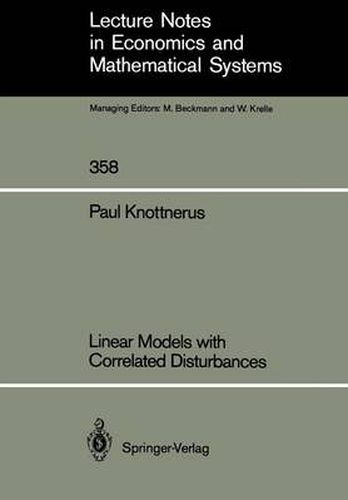Readings Newsletter
Become a Readings Member to make your shopping experience even easier.
Sign in or sign up for free!
You’re not far away from qualifying for FREE standard shipping within Australia
You’ve qualified for FREE standard shipping within Australia
The cart is loading…






This title is printed to order. This book may have been self-published. If so, we cannot guarantee the quality of the content. In the main most books will have gone through the editing process however some may not. We therefore suggest that you be aware of this before ordering this book. If in doubt check either the author or publisher’s details as we are unable to accept any returns unless they are faulty. Please contact us if you have any questions.
The main aim of this volume is to give a survey of new and old estimation techniques for regression models with correlated disturbances, especially with autoregressive-moving average disturbances. In nearly all chapters the usefulness of the simple geometric interpretation of the classical ordinary Least Squares method is demonstrated. It emerges that both well-known and new results can be derived in a simple geometric manner, e.g., the conditional normal distribution, the Kalman filter equations and the Cramer-Rao inequality. The same geometric interpretation also shows that disturbances which follow an arbitrary correlation process can easily be transformed into a white noise sequence. This is of special interest for Maximum Likelihood estimation. Attention is paid to the appropriate estimation method for the specific situation that observations are missing. Maximum Likelihood estimation of dynamic models is also considered. The final chapter is concerned with several test strategies for detecting the genuine correlation structure among the disturbances. The geometric approach throughout the book provides a coherent insight in apparently different subjects in the econometric field of time series analysis.
$9.00 standard shipping within Australia
FREE standard shipping within Australia for orders over $100.00
Express & International shipping calculated at checkout
This title is printed to order. This book may have been self-published. If so, we cannot guarantee the quality of the content. In the main most books will have gone through the editing process however some may not. We therefore suggest that you be aware of this before ordering this book. If in doubt check either the author or publisher’s details as we are unable to accept any returns unless they are faulty. Please contact us if you have any questions.
The main aim of this volume is to give a survey of new and old estimation techniques for regression models with correlated disturbances, especially with autoregressive-moving average disturbances. In nearly all chapters the usefulness of the simple geometric interpretation of the classical ordinary Least Squares method is demonstrated. It emerges that both well-known and new results can be derived in a simple geometric manner, e.g., the conditional normal distribution, the Kalman filter equations and the Cramer-Rao inequality. The same geometric interpretation also shows that disturbances which follow an arbitrary correlation process can easily be transformed into a white noise sequence. This is of special interest for Maximum Likelihood estimation. Attention is paid to the appropriate estimation method for the specific situation that observations are missing. Maximum Likelihood estimation of dynamic models is also considered. The final chapter is concerned with several test strategies for detecting the genuine correlation structure among the disturbances. The geometric approach throughout the book provides a coherent insight in apparently different subjects in the econometric field of time series analysis.